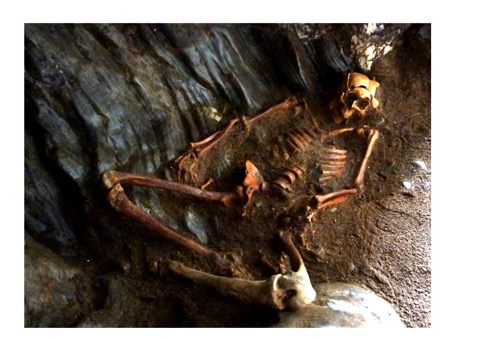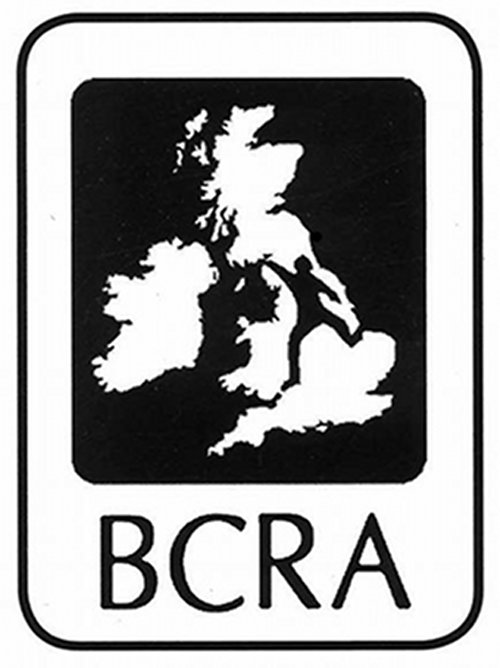Rosemarkie Cave Project
A group of amateur and professional archaeologists have been investigating 19 caves on the shore of the Black Isle (just NE of Inverness). Over the past 6 years, the project members have carried out two excavations, dating usage of one of the caves to 300 BC. The caves are sea caves, though are now situated high and dry on raised beaches. The caves vary in size, the biggest of which could house a bus, the smallest being an uncomfortable crawl.
The group is presently surveying the Rosemarkie Caves in preparation for more archaeological work. As well working on Iron Age dating, the group has been exploring Traveller/Gypsy Archaeology, which doesn't seem to have been covered in the past.
The Black Isle is a peninsular on the north side of the Moray Firth and has a number of old sea caves that are high and dry as Scotland's landmass is rising and leaving the sea behind. The members of the Rosemarkie Caves Project (part of the North of Scotland Archaeological Society) are hopeful that they might find evidence of use of the caves going back for 5000 years. Excavation on the West coast of the Highlands has revealed use of caves there going back further than that, while Mesolithic remains have been found both on the Black Isle and in the surrounding area, though not in caves as yet.
In June 2010, a 2 week excavation of Cairds' Cave took place near the village of Rosemarkie. Charcoal and bone were found in the lowest layer of the floor dating back to 300BC. Other samples in the higher layers indicated use of the cave for at least 1000 years after that. It is believed that travellers used the cave until WW1, the name Cairds' Cave means the Gypsies' Cave.
Since then, the team have surveyed the other 18 caves in their "patch" (a 2 mile section of coastline) and have started test pit digging in selected caves. The survey was revealing and provided the opportunity to look carefully at the caves without having too many thoughts about what may be buried underfoot. This was the case with Ivy Cave, when preparing tapes for measuring, a slab of sandstone carrying engraved marks was noticed on the lowest area of the floor. One photograph (see top right) shows Simon pointing to it on the floor and the second shows the engraved design. In this part of the world engraved or carved stone slabs usually have links with the Picts, but that doesn't seem to be the case with this one. The belief is that that many of the caves were used by gypsy travellers in the 18th and 19th centuries, perhaps this design has some traveller significance. Various suggestions have been made though ~ a deer's head, a volcano or turned up the other way, a bad drawing of a rowing boat. Any ideas? http://www.spanglefish.com/RosemarkieCavesProject/index.asp?pageid=200209
Many thanks to Simon Gunn and his team for this exciting Press Release from the Rosemarkie Cave Project
ARCHAEOLOGISTS UNCOVER SKELETON OF 1,400-YEAR-OLD MAN WHO SUFFERED A VIOLENT DEATH IN THE BLACK ISLE
Black Isle, Ross-shire – Archaeologists excavating a cave in the Black Isle have uncovered the remains of a man who had been brutally murdered more than 1,400 years ago. Archaeologists from the Rosemarkie Caves Project had been expecting to find some evidence of human occupation of the cave extending back over a long period of time but they were astonished to find the skeleton of a man buried in a recess of the cave, covered in a layer of sand. The bones were sent to an expert forensic anthropologist whose team have been able to describe in detail the horrific injuries he sustained as well as digitally reconstruct what he looked like. A bone sample sent for radiocarbon dating indicates that he died sometime between 430 and 630 A.D., commonly referred to as the Pictish period in Scotland.
---------------------------------------------------------------------------------------------------------------------------
Under the leadership of local amateur archaeologist Simon Gunn, the team of volunteers from North of Scotland Archaeological Society were digging to determine when the cave might have been occupied. Below substantial layers relating to cave use since the 20th century, they found evidence that the cave had been used for iron-smithing during the Pictish period. Hearths and extensive iron-working debris indicate that the cave was selected specifically for this use, but the totally unexpected find of the skeleton of a man who had been brutally killed gives the cave a completely different significance. The burial was located in an alcove of the cave, near the metal-working area. The body had been placed in an unusual cross-legged position, with large stones holding down his legs and arms. Prior to its discovery, there had been nothing to suggest that it was there.

Human skeleton found on the final day of the excavation.
The remains were sent to Professor Dame Sue Black, director of the Centre for Anatomy and Human Identification at the University of Dundee, and from her extensive experience of analysis of human remains was able to compile a detailed account of how the man died. She told us:
“This is a fascinating skeleton in a remarkable state of preservation which has been expertly recovered. From studying his remains we learned a little about his short life but much more about his violent death. As you can see from the facial reconstruction he was a striking young man who was sadly cut down in his prime by brutal interpersonal conflict. We have identified at least 4 or 5 impacts that resulted in fracturing to his face and skull. The first impact was by a circular cross-section implement that broke his teeth on the right side. The second may have been the same implement used like a fighting stick which broke his jaw on the left. The third resulted in fracturing to the back of his head as he fell from the blow to his jaw with a tremendous force possibly onto a hard object perhaps stone. The fourth was intended to end his life as probably the same weapon was driven through his skull from one side and out the other as he lay on the ground. The fifth was not in keeping with the injuries caused in the other four where a hole, larger than that caused by the previous weapon, was made in the top of the skull. Was this a coup de grace or was it done after death in some form of ritual in keeping with the stones buried on his body? We simply can't tell.”
On receiving Professor Black’s initial assessment, Steven Birch, a local professional archaeologist and volunteer leader of the excavation, was amazed to learn about the amount of trauma the deceased man had sustained. 'Having specialised in prehistoric cave archaeology in Scotland for some years now, I am fascinated with the results. Here, we have a man who has been brutally killed, but who has been laid to rest in the cave with some consideration - placed on his back, within a dark alcove, and weighed down by beach stones. The style of the death, which included considerable 'overkill' is reminiscent of the Iron Age bog bodies, examples of which had been pinned down in watery pools using wooden stakes and hurdles. While we don’t know why the man was killed, the placement of his remains gives us insight into the culture of those who buried him. Perhaps his murder was the result of interpersonal conflict; or was there a sacrificial element relating to his death?'
Simon Gunn is the founder of the Rosemarkie Caves Project, whose aim is to investigate the archaeology of caves in the Black Isle. For some years, the group has been locating and accurately surveying the series of caves extending for several miles along the coast of the Black Isle. A number of small test-pit excavations over the last few years have provided evidence that the caves were being occupied, or at least utilised in some way, from 1,500-2,000 years ago until the recent past. Simon said:
"When I first started looking into these caves, I never dreamt we would find anything like this: it was so unexpected. I remember all the excitement when the remains of Richard III were found under a carpark. Well, Rosemarkie Man died 900 years before that so you cannot imagine our reaction when we first uncovered these human remains and then learned about his brutal death”.
The cave excavation has also provided information about the more recent past, including objects left behind by occupants and temporary travellers living inside the cave 200 to 300 years ago. Evidence from this later period suggests that the inhabitants were making, or repairing, leather shoes, possibly for distribution to local communities on the Black Isle.
Ongoing specialist analysis on the skeleton and artefacts from the cave is expected to provide more details of the man’s place of origin and significance as well as provide more information about the cave’s archaeological and historical importance.
For more information: Website: www.spanglefish.com/rosemarkiecavesproject
Contacts: Steve Birch skyesub1@aol.com
Simon Gunn simonjgunn@hotmail.com
Photographs copyright Rosemarkie Caves Project
If you would like a cave project included on this site, please use the link at the bottom of this page to contact us.
